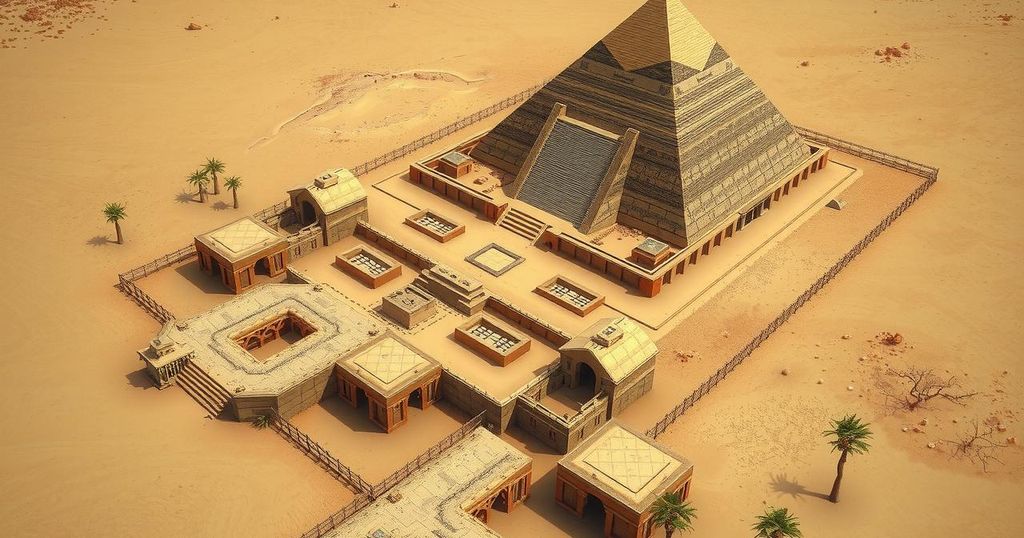A team of Italian researchers claims to have discovered a vast underground city beneath Egypt’s Giza pyramids, featuring vertical shafts and an advanced water system. Their findings suggest the existence of undiscovered secrets within the Khafre Pyramid. While skepticism surrounds these claims, researchers assert the presence of multiple hidden structures. Advanced radar technology was utilized to create high-resolution images of the underground formations, although experts call for peer-reviewed validation.
Recent revelations shed light on a purported “underground city” beneath Egypt’s Giza pyramids. A collaborative team of researchers from Italy has purportedly identified significant vertical shafts featuring spiral staircases and a large limestone platform with expansive chambers that include channels reminiscent of pipelines. These structures were reportedly located over 2,100 feet below the Khafre Pyramid, with corridors extending deeper underground.
During a recent press conference, the scientists presented evidence of a water system lying beneath the limestone platform. They employed radar technology to generate detailed images beneath the Earth’s surface, akin to sonar mapping the ocean depths. Despite skepticism from certain experts who deem these claims exaggerated, the researchers are resolute, stating there exists “an entire hidden world of many structures” buried beyond the water system.
Corrado Malanga from the University of Pisa expressed confidence in the existence of this underground city, promising that future magnifications of their images will provide clearer insights. Furthermore, the research hints at potential undiscovered elements in the Khafre Pyramid, possibly including the legendary Hall of Records associated with ancient Egyptian mythology.
Professor Lawrence Conyers, a radar specialist at the University of Denver, cautioned that technology may not effectively penetrate such depths, labeling the notion of a vast underground city as an exaggeration, although he acknowledged the possibility of archaeological features like shafts existing beneath the pyramids. He drew parallels to ancient Mesoamerican cultures that built pyramids atop sites of ceremonial significance.
The researchers, including Malanga and Filippo Biondi, shared their findings in an announcement following an in-person briefing in Italy. The exploration primarily centered on the Khafre Pyramid, which forms part of a trio of pyramids, including those of Khufu and Menkaure, all constructed approximately 4,500 years ago.
Identified vertical shafts beneath the Khafre Pyramid measured between 33 to 39 feet in diameter, situated at depths around 2,130 feet, and may provide foundational support for the pyramid structure. This raises concerns regarding the stability of such grand edifices, with Malanga stating that significant load-bearing structures are crucial for support.
The research team also revealed insights into large rectangular enclosures, estimated to be 260 feet per side, featuring shafts that extend downward. Within this context, Ciccolo highlighted images produced by radar technology that portray the Khafre Pyramid alongside a complex structure that they believe constitutes an underground city.
Further reinforcing their findings, Malanga and Biondi previously published peer-reviewed research indicating hidden rooms and ramps within the Khafre Pyramid, alongside signs of thermal anomalies. Utilizing satellite-based radar technology, the new exploration generated 3D maps of uncharted subterranean structures, permitting a more thorough examination of the area beneath the pyramids.
The data derived from satellite signals confirm a consistent understanding of the underground layout, ensuring precision in their analysis. Malanga elaborated that the validation process of the data is crucial to eliminate the risk of erroneous interpretations due to sound reflections from the environment.
In conclusion, the exploration beneath Egypt’s pyramids has unveiled promising yet contentious discoveries, proposing the existence of a vast underground city. The research, albeit met with skepticism, highlights the application of advanced radar technology in uncovering potential archaeological treasures. The implications of these findings, if validated, could significantly enhance our understanding of ancient Egyptian civilization and its architectural marvels.
Original Source: www.tbsnews.net






